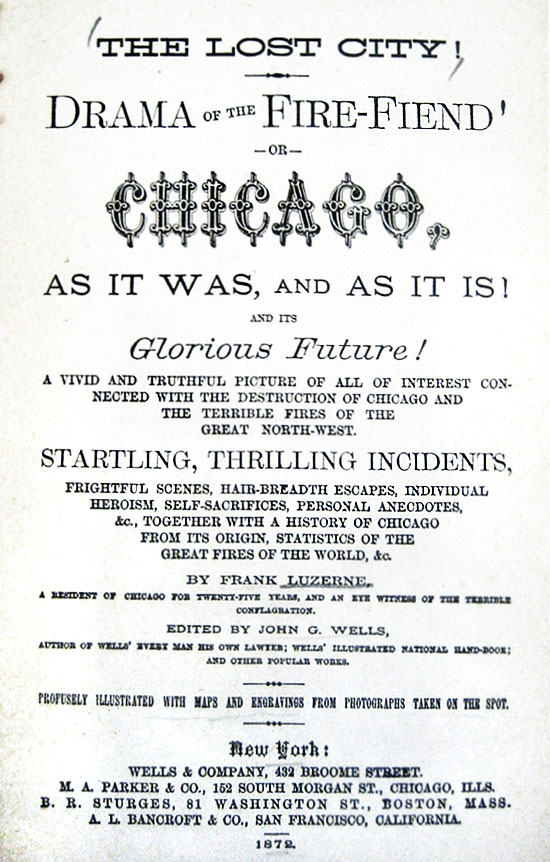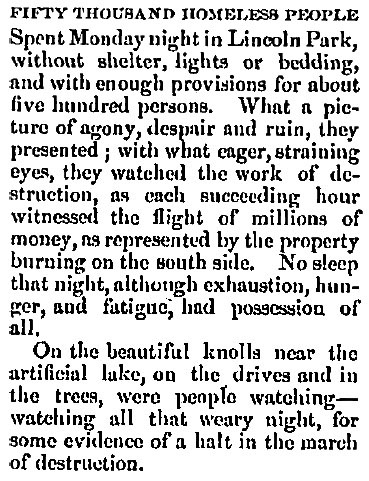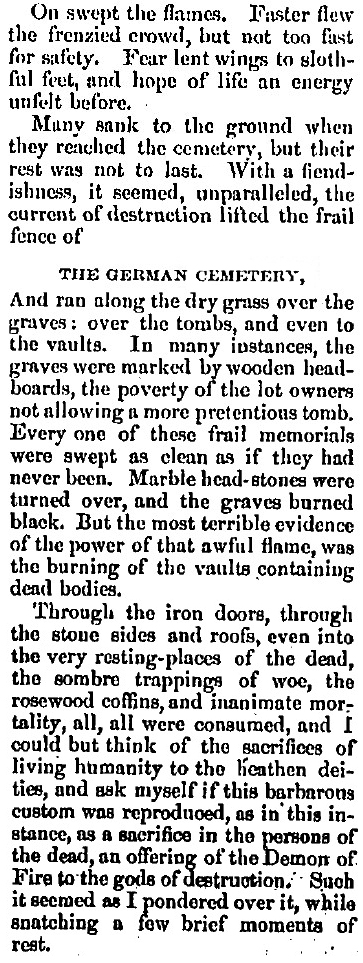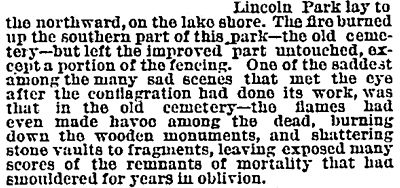Personal accounts of experiences during the Chicago Fire began being published almost immediately after the event. There were publications ranging from pamphlets, to heavy volumes that relayed individual stories and other, more general accounts of the destruction. Several books were published with similarly breathtaking titles, as the book, below. Also, the Chicago Historical Society began collecting personal narratives, and continued gathering those testimonials until the 1940s. See a selection of the personal stories from that collection at The Web of Memory, part of the The Great Chicago Fire and the Web of Memory Web site.
In accordance with a goal of this project - to visualize the early cemetery grounds - at the right, are excerpts from accounts that include descriptions of Lincoln Park or the Catholic or City cemeteries.

|
Chicago Tribune, October 11, 1871
Striking Lincoln Park, the trace of the bosom of destruction is visible even there. The fences have all gone, and some of the railings around the graves in the Old Cemetery are scorched and burned. The fire did not penetrate far into the park, as it did not reach it until about 11 o’clock on Monday night, when the welcome rain was falling in torrents.
Just here it may be interesting to state that at the same hour, the flames caught John A. Huck’s house, beyond the city limits and it was the last house destroyed.
The house No. 863 Clark street, a saloon opposite Lincoln Park, kept by Mr. C. Raggis stands, unharmed, and so do two houses a short distance south, one of them being a handsome brown front house not entirely finished. The escape of these buildings may be attributed to their isolated position.
New York Times, October 21, 1871
To the north could be seen only a waste of ashes, with here and there portions of calcined walls standing as monuments of the ruins. Reaching the street nearest the lake, and turning northward, it was still a wilderness of ruins behind me, before me, and upon my left. Far away to the northwest I could see the vast remnants of St. Michael’s church, and directly before me the scorched foliage of Lincoln Park. …
Leaving my informant I still walked northward until I reached North-avenue, which skirts the southern side of Lincoln Park, and through this street I went westward. The street did not belie its name. It actually bounded the compactly-built city upon this side, and all up to it is destroyed. The fire upon this side had stopped only because there was nothing more to burn, but practically the fire was stopped at the avenue, although the block above it, and on the extreme western limits of the fire, are the ruins of the great German Roman Catholic Church of St. Michael, the largest religious edifice in the city.
from the Reformed Church newspaper, October 25, 1871
(an excerpt)
 |
(another excerpt from the Reformed Church article of October 25, 1871)

|
Chicago Tribune, December 10, 1871, this excerpt was published as part of a pre-publication presentation from the book,
Chicago and the Great Conflagration, by Elias Colbert and Everett Chamberlin.

______________________________________________
The great fires in Chicago and the west. History and incidents, losses and sufferings, benevolence of the nations, &c., &c. By a Chicago clergyman. To which is appended a record of the great conflagrations of the past. Illustrated with map and scenes.
Chicago, New York: J. W. Goodspeed, H. S. Goodspeed: 1871.
p. 32
Lincoln Park and the old City Cemetery deserve special mention. Lincoln Park – the glory of the North division – has been almost entirely preserved. But few trees have been injured, except in the south-eastern portion of the park where the dead-house stood and where a few trees were burned; the small-pox hospital to the east on the lake shore being also destroyed. The grave-stone or rather board memorials of the dead poor are many of them destroyed, and their relatives well know no more the place of rest of their kindred. The fences around the graves, the boards which have told to the wanderer their names, are all destroyed in the southern portion of the old cemetery. In the park itself many took refuge, though the great majority, as hereafter stated, fled to the prairies to the north-west.
The Great Conflagration – Chicago: Its Past, Present and Future
James Washington Sheehan, 1871
p. 16
Nothing but the destruction of Pompeii can outline the savageness and rapidity of its career. It fed on everything – the Nicholson pavement of the streets, the sidewalks, the fences; for example, one instance in many, a lady and her children took refuge four times, and four times that flaming sword pointed “onward!” until she found shelterless safety, with hundreds of others, five miles from home, on the open prairie, where they passed the fearful night. Others were surrounded by the fire and rushed into the lake, where, by plunging under the water as the heat became unbearable, they saved their own and children’s lives. Again, delicate women fled along the streets, their footsteps licked by the dogging flames, igniting their hastily-donned clothing. A cry! A stop! And the fire is put out by some friendly hand; that brief stop is almost fatal, and the utmost speed is needed to regain lost ground in this race for life. Into the old graveyard – over the graves of the dead – fled the living, as through the dry grass and over the fences and trees crept or leaped the enemy, beyond all houses, into Lincoln Park, on to the barren lake shore; and there, exhausted, they sank thankful on the sand.
|
The Great Conflagration – Chicago: Its Past, Present and Future
James W. Sheehan and George P. Upton, Union Publishing, Chicago: 1871
p. 104 - 106
The Grave Yards
A mile or more north of the water works and extending to within 200 yards of the lake, was the Roman Catholic grave yard, and next it was a German grave yard. Interments had ceased in these some years ago, but all the bodies had not been removed to the new cemeteries farther up the lake. These cemeteries had been contemporary with the city. A large part of them was donated to the graves of the poor and strangers. As a general thing surviving friends, who had the means, long since removed the bodies of their kindred; those who remained had been the husbands, wives and children of the poor, but were none the less dear. These graves were marked with wooden boards, upon which were painted or cut the initials of the dead, and occasionally some beyond. In even one yard, the inscriptions were in German. Even in these abandoned cities of the dead, hundreds would spend the long summer afternoons trimming the sandy mounds, straightening the loose boards, and bringing water from the lake to refresh the parched plants and flowers which affection had planted upon the graves. Into these grave yards many fugitives had fled during that Sunday night and Monday morning. With them were carried some household goods. Stands, beds, chairs, tables, the whole presenting a strange collection. The occupants were of all classes. Strong men, hard working able bodied men; weak and delicate women; many of the occupants of fashionable dens of vice; refined and cultivated women; merchants, lawyers and bankers; servant men and women, but the great bulk were the families of small tradesmen, and working people of the neighborhood. Of course there were troops of children, all huddled in groups, with backs to the fire, to protect their eyes from the blinding smoke and consuming heat. Incessantly there fell among them the flying sparks and cinders. In vain did these poor fugitives seek to cover their packages of clothing with sand. The fire would fall upon them and set them ablaze. At last the fire approached them; it seized upon the long wooden sidewalks of the streets beyond, and with the speed of lightning traversed block after block, encircling every place with a cordon of fire. The fences one after another caught, the twigs, and scattered lumber, with here and there a house, a stable, or a shed seemed to furnish food enough to carry that fire along. At last it reached the grave yard, the fences caught and blazed; the heat prepared everything for the advancing column of fire. Group after group fled before the flame; the straw beds, chairs, tables, the trunks, the bundles of clothes and the household goods, soon were on fire; head board after head board blazed as a brazen mirror reflecting light. The little fences around the burial lots, the scanty trees and shrubbery all took fire, and each fed the rapacious flames. The living had to abandon even the desolate grave yard, and the fire swept from the earth everything that was consumable. Stout trees were burned down below the ordinary level of the soil in which they grew. These cemeteries before the fire were desolate – one half the dead having been disentered, and the monuments and valuable adornments removed, and now came the fire to make desolation more desolate, not a vestige remains of anything in these silent cities of the dead save the blackened embers of the once erect grave signs, and of the little property carried there for safety and then overtaken and consumed by the insatiable fire.
|
Chicago and the Great Conflagration, by Elias Colbert and Everett Chamberlin, J.S. Goodman and Co., Chicago: 1871
p.265 - 267
At Lincoln Park and the old cemetery to the south of it, and along the Lake-shore Drive, the number of refugees was much greater and their sufferings much less. They were not imprisoned by the hostile elements; they were not threatened with death. They had merely lost all their property – even being compelled to see the household goods and valuables which they had they had moved into the cemetery or park burn up before their eyes. They had only to lament the probable fate of a missing father or brother, or to hope against hope for his safe return. As to physical condition, they were simply blinded by smoke, weakened by hunger, and choking with thirst at every gland and pore – that was all. So these Lincoln Park and cemetery victims might be pronounced very comfortable off!
The scene in the cemetery was a very weird one, as may be imagined. It is an old burial-ground, from which many of the bodies had been removed. Leaving some old headstones scattered about, and many, with their mounds, still standing among the thick undergrowth of grass and small oak trees. By nightfall on Monday there could not have been less than thirty thousand men, women, children, huddled within this ghostly inclosure. Some had sat here all day, seeing the devilish flames advance from street to street, from mile to mile, and others now rushed in breathless, dragging a trunk, or carrying some bundle, piece of furniture, or household utensil. Almost all the new-comers ran rapidly about, crying for a brother, sister, child, or friend. As twilight became dusk, and dusk reddened into the mock daylight furnished by the conflagration, the assembled thousands, tired of searching for friends, disconsolately sought resting-places for the night among the grass-grown graves.
To quote the description of a writer in the World: “The eyes of all looked as if they suffered from ophthalmia – black and red with smoke and cinders till they were almost blind. There were piles of every sort of furniture that ever came to the city. There were pails, bureaus, chairs, tables, trunks, tubs, clocks, great plate mirrors leaning against trees and flashing back the illumination, a few bedsteads in need of reconstruction, clothes in little piles, carpets, pictures, rolls of cloth here and there, new shoes on strings, and suspicious-looking boxes that had been ‘saved’ from jewelry stores by the wrong men. Here is a group of girls wailing in a poor, heart-broken way for their mother – their sick mother – whom they left in a burning bedroom. Here is a refined an handsome lady, all alone, with a bundle of dresses on her right arm, and a caster laid by her side on the ground. Here is a strong, able-bodied man, recognizable as a banker, sitting sadly on a grave, with his hat over his aching eyes, gazing thoughtfully into a frying-pan which he holds in his hand. Every-where are rushing crowds, exclamations, salutations of woe in every language under heaven, and weeping aloud by those who have lost their friends and will not be comforted. Here comes a young man who exhibits an ice-pitcher, and laughingly declares that it is all he possesses in the world. There are no strangers here. There are no ceremonies. The cement of a kindred sorrow has done its work. Every body speaks freely to any body, and even the churl finds his human-side and turns it genially toward us.
“Meantime the roaring ocean of flame nears us. It bombards even this sacred necropolis with its hellish missiles. Every-where among the dead leaves fall the blazing embers. The torches alight head first upon the hollow graves. Group’s dodge and run, and here ant there a fire is kindled by the brands, and there is a struggle to stamp it out. The fire howls up to heaven, and bends and bows over the cemetery like an iris of doom. The park is lighted up as by a million fire-balloons, sailing over in endless succession. Now the dead-house is afire, and a shudder of horror runs through the multitude. It defies the extinguisher. It burns until it is consumed. But it was, happily, tenantless. At the head of the graves stands usually a cheap pine head-board, and these in many instances are burned up, and in a few cases the fire burrows down into the peaceful tenement beneath, for the drought has been so severe that the very soil is combustible. At last the raging sea sweeps by to the northward, following the line of houses, and the most reckless or courageous of these elfin junketers lie down upon the graves to sleep – the queerest camp that ever gathered under heaven. At two o’clock came the blessed rain, and the multitude shivered with chill while they welcomed it. It was a dreadful night in the cemetery. |
Chicago Tribune, October 9, 1872
(excerpt from anniversary story)
At the northern end of the Division was Lincoln Park, the special pride of the inhabitants, and, to some extent, of all Chicago. It was approached through an abandoned cemetery, whose uncared-for graves and leaning headstone did not, however, incline to solemn and sober reflections those who went to stroll along the wooded paths, or beside the pleasant lakes, or upon the sandy beach of the great lake whose many-hued surface stretched far eastward. AS the North division was in point of population the smallest, it was also, as is the case with little communities, the most patriotic. Its denizens were always prompt to maintain the superiority of that part of the city. The amenity of its climate, and its superiority for residence purposes, were themes which they were never weary of discussing. They looked down upon other Chicagoans as South Carolinians did upon other Southerner, and they pointed proudly to their park, their Water-Works, and their lovely and secluded homes.
Through The Flames and Beyond: or Chicago as it was and as it is. – by, Frank Luzerne. Wells and company, New York: 1872
p. 96
Now the fire advanced without enemy to oppose it, and swept on towards the cemetery which bounded Lincoln Park on the South. The fire department had drawn off to the lake-shore, there to oppose the progress of the rushing whirlwind of fire by another mode of attack, while the flames were swallowing all the buildings in the direction of Lincoln Park. One remarkably handsome wooden residence, together with a fine conservatory, were spared, however, by the hungry element which left no other building standing in its destroying path. The ghoulish flames even battened upon the tombs and monuments, licking up wooden crosses and signs, and even devouring the trees that shadowed, and the grass that grew upon the graves of the dead. It could gain no hold, however, upon the green foliage and shrubbery of Lincoln Park, whereupon it changed its course to the North-west. It licked up everything until it reached the prairie, and then it burned up acres of prairie grass and trees.
The Lakeside Memorial of The Burning of Chicago,
The University Publishing Company, Chicago: 1872
p.37 written by William S. Walker
By nightfall of Monday, a great number of refugees ahd collected in the cemetery at the south end of Lincoln Park, and many had endeavored to dispose themselves as comfortably as possible until the light of another morning should enable them make their final escape. But the fire-wraith hesitated not at the pollution of the quiet homes of the dead, and was soon curling the leaves and snapping the brush at the cemetery’s entrance. Another stampede was all that was left to the heart-sick multitude of living ones, who had vainly thought to catch a few hours of fitful rest upon the graves o the sleepers below, whom even this tyrant conflagration could not touch. Out from the cemetery swarmed the stricken ones, and into the park, from which they were again routed by the untiring pursuit of the wind and the flames.
|
The Lakeside Memorial of The Burning of Chicago, The University Publishing Company, Chicago: 1872
p.41 written by H.R. Hobart
“To the lake!” was the instinctive cry of thousands, and soon the beach of that great but now almost useless reservoir was lined with the frantic multitudes and such effects as they could save. But the relentless demon pursued even here, showering upon them his rain of fire, and many preserved themselves from actual burning alive only by covering their bodies with blankets, frequently removed to be soaked in the water. Farther up the shore many sought refuge in the old burying-ground, hiding themselves in the vacant graves; and many wretched hearts, weighed down with the loss of every earthly possession and fearing that they had looked their last upon dear ones from whom the frenzy of the flight had parted them, earnestly wished for the peace of the new-made grave and the protection of the grassy mound which fire cannot penetrate and beneath which the trampling hoofs of flame are never heard.
Ere long Lincoln Park, the resort of gayety and fashion, was thronged with the fleeing multitude; and here some security was found, the walls of green keeping back the tide of fire, though falling brands flashed momentarily among the distracted groups and set fire to treasures painfully brought hither, after repeated removals, only to be consumed. Thousands and thousands more stopped not to trust themselves even here, but pushed on, miles to the northward, to the open prairie beyond the city; and there night overtook them, homeless, foodless, illy-clad, exhausted, almost broken hearted. That night of cold and rain, by the lake shore, among the tombs, in the dark woods, and upon the desolate waste, with neither fire nor food nor shelter, formed a fitting close of the horrors of that awful day.
Our First Century: Being a Popular Descriptive Portraiture of the One Hundred Great and Memorable Events of Perpetual Interest in the History of Our Country, Political, Military, Mechanical, Social, Scientific, and Commercial: Embracing Also Delineations of all the Great Historic Characters Celebrated in the Annals of the Republic; Men of Heroism, Statesmanship, Genius, Oratory, Adventure and Philanthropy. Published by Nichols & Co., Springfield, Mass., A.W. Mills, Toledo, Ohio: 1876
p. 926
Even the homes of the dead were sought for as food by the all-devouring element; for, after ravaging to the limits of the city, and with the wind dead against it, the fire caught the dried grasses, ran along the fences, and in the moment covered in a burning glory the Catholic cemetery and the grassy stretches of Lincoln park. The marbles over the graves cracked and baked, and fell in glowing embers on the hot turf. Flames shot up from the resting places of the dead, and the living fugitives, screaming with terror, made,for a moment, one of the ghastliest spectacles ever beheld. The receiving-vault, solidly built, and shrouded by foliage, fell under the terrific flame, and the corpses dropped or burst from the coffins, as the fire tore through the walls of the frightful charnel-house.
|
Twenty-five Years in the West, by Erasmus Manford, published by Mrs. H.G. Manford, Chicago, 1885
p. 368
The fire burned up the southern part of this park – the old cemetery – but left the improved part untouched, except a portion of the fencing.
History of the Swedes of Illinois, Part 1, Edited by Ernst W. Olson, in Collaboration With Anders Schon and Martin J. Engberg. Chicago: The Engberg-Holmberg Publishing Company, 1908.
P. 110
Thousands took refuge westward across the north branch of the river, while other thousands fled to the lake front. The latter soon discovered their mistake. As the fire approached, they were enveloped in dense clouds of smoke and exposed to a shower of sparks and flying embers that ignited the personal property deposited there. The heat grew more suffocating for every passing minute and finally became unendurable, forcing those who had not fled north along the lake front to wade into the water for protection and remain there until they could be taken away in boats. The flames spared not even the city of the dead. The Catholic cemetery near Lincoln Park was ravaged, charred wooden crosses and cracked marble shafts bearing evidence of the destruction wrought.
October 12, 1925
Account by Frank J. Loesch,
“Personal Experiences During the Chicago Fire”, read before the Chicago Literary Club: (excerpts)
“Our walk was down Lincoln Avenue to Clark Street, thence into Lincoln Park at Wisconsin Street to North Avenue. There were still many graves in the old cemetery south of Wisconsin Street which had been incorporated within the park limits. Not a wooden marker escaped the flames while former granite and marble headstones were in evidence only by the chips left of them which littered the ground. Broken china was everywhere, plainly the remnants of household things which had been carried there for safety and then abandoned to the flames which swept the dry grass, shrubbery and trees out of existence.
“We could note the line of trees along Clark Street abutting the walk, which had burned down to the soil. A former double row of Lombardy poplars which had lined the roadway to the park from Clark Street and North Avenue northeasterly could only be traced by the blackened spots scarcely above the surface. There were only a few people about in the burned over district. There were no police, no militia and no soldiers. It was a desert – a universal ruin with here and there only showing a stone or brick remnant of the wall of a church or of some former substantial business building, where a big city of people had lived in general happiness only three days before.
|